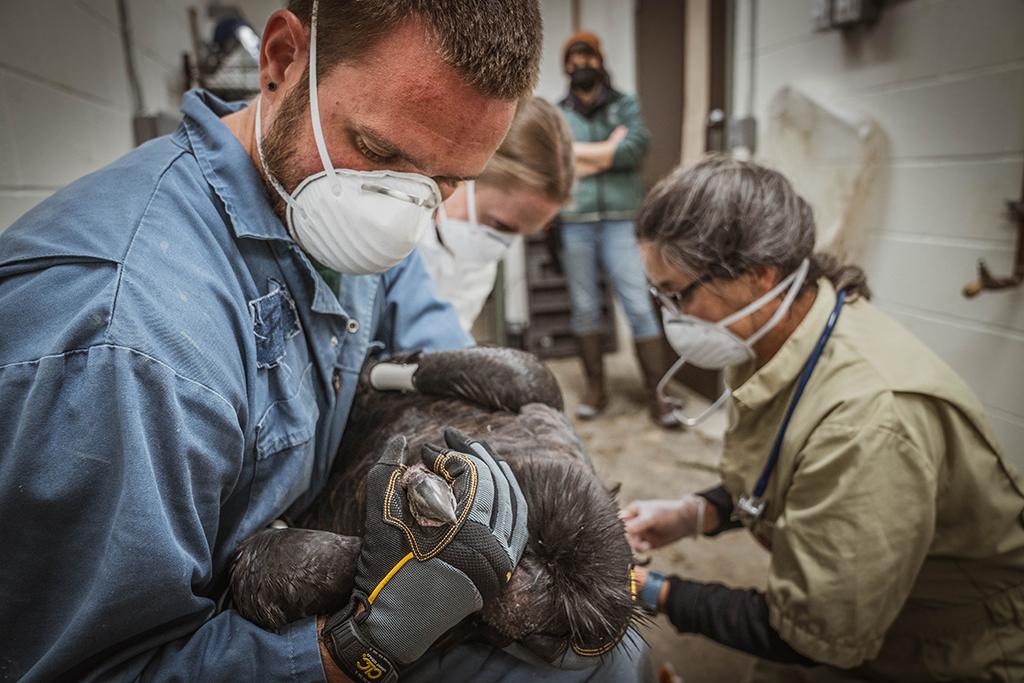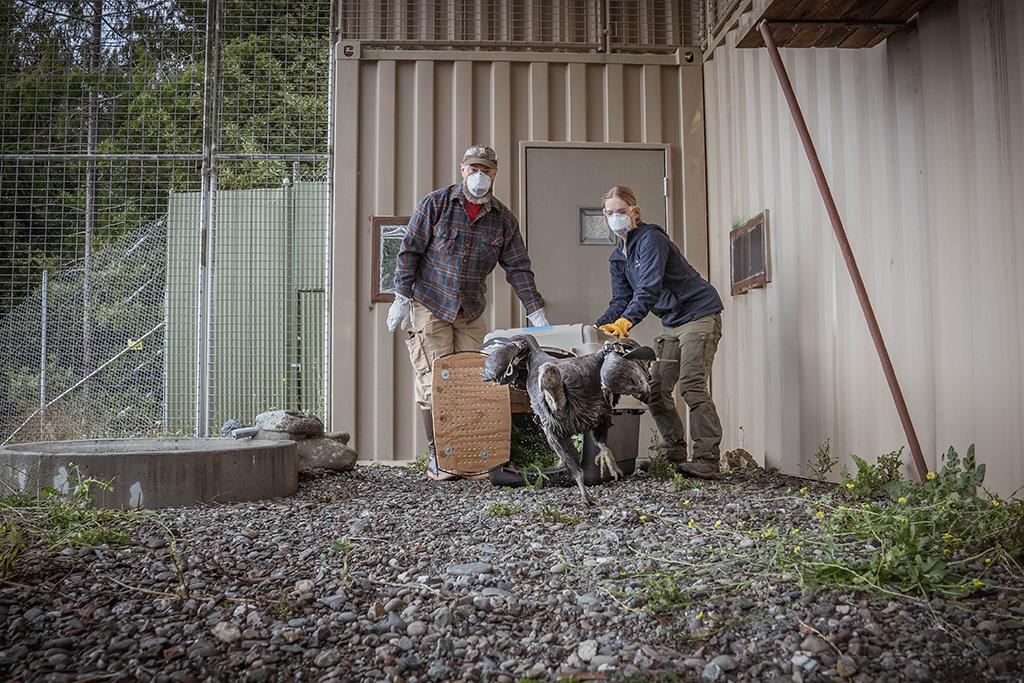
Nate Krickhahn and Dr. Jennifer Tavares from Sequoia Park Zoo work on Me-new-kwek’ (Condor Recovery Program Studbook 1101: wing tag designation A6) / Yurok Wildlife Department Technician Madeleine Rifka
Earlier this month, Yurok condor A6 (Me-new-kwek’, "I am bashful or shy"), along with several other condors in the new population, fed on a poacher-killed elk within Redwood National Park in the Bald Hills of Humboldt County. In a routine autumn health check conducted a few days later, five out of eight birds were found to have concerning levels of lead in their blood. For seven of these birds, this event was likely their first time accessing food not provided by the Northern California Condor Restoration Program (NCCRP), based on the intensive daily monitoring. Due to the timing, visual observations and other factors, the illegally killed elk is believed to be the source of the toxin uncovered during the birds’ health assessment.
Of the five birds, Me-new-kwek’ (Condor Recovery Program Studbook 1101: wing tag designation A6) was the only one whose lead level came back higher than the identified treatment threshold, warranting immediate medical intervention for lead poisoning.
While in hand, lead chelation therapy was initiated on Me-new-kwek’ at the NCCRP’s Condor Release and Management Facility in Northern California. The condor was transported the following day to Sequoia Park Zoo (SPZ) and received a series of x-rays to determine if there were lead fragments still in his digestive tract. The scan came back clear, indicating that what he ingested would have been dust-like in composition. After completing one round of chelation therapy at SPZ (5 days of injections and fluids), his blood lead level had decreased to below the treatment threshold, and Me-new-kwek’ was returned to the NCCRP flight pen. He will remain in the pen to improve his health before release, and to serve as a mentor for incoming birds. The chelation drugs (Calcium EDTA) are designed to bind to the lead in the condor’s system while extra fluids dilute the high levels of lead subsequently passing through liver and kidneys to minimize organ damage. This therapy is hard on the birds, tiring them considerably, but it has been used to reduce lead levels over the decades of the recovery efforts.
Foraging on opportunistically found food is part of becoming a wild condor, but feeding on animals harvested with lead ammunition comes with a big risk for this recovering species.
Lead poisoning from ingestion of lead ammunition is the single largest threat to free-flying condors. Lead exposure has hindered recovery efforts throughout the condor’s current range in the US, including California, Arizona, and Utah. Many hunters and poachers shoot large game through the vitals (the heart and lungs) to quickly dispatch their quarry. These parts often comprise a portion of the gut piles left behind, and frequently contain high quantities of lead if lead bullets are used to dispatch the animal. A very small piece of the soft metal is enough to make a scavenging animal ill, and can even kill a condor, eagle, or most any other scavenging bird. Lead ammunition mushrooms and fragments upon impact with an animal, scattering countless particles within the tissues. As obligate scavengers which rely solely on carrion, condors (prey-go-neesh in Yurok) will feed on these remains. Gut piles from non-lead shot game provide a clean source of sustenance for condors and other wildlife. In 2019, California banned the use of lead bullets for hunting in the state.
The return of the condor to Yurok ancestral territory and the cultural and ecological restoration of the landscape requires a transition to non-lead ammunition. The Yurok Tribe has worked for over a decade on non-lead outreach prior to the arrival of the prey-go-neesh, with growing investment by local partners such as Green Diamond Resource Company who last year joined the North American Non-lead Partnership which includes over 40 organizations committing “to collaborating with hunters to improve ecosystem health for scavenging wildlife.” Hunter involvement is invaluable in decreasing the amount of lead on the landscape. A similar educational approach has been successfully employed, through the hard work of the Peregrine Fund and the Arizona Game and Fish Department, in Arizona to reduce lead poisonings among their condor populations. Efforts to reach out to ever more hunters and land managers who use ammunition in hunting or as a management tool continue. Less than a month ago, another condor safely consumed her first wild meal. A7 (He-we-chek’, “I am healthy”) fed on bear and deer carcasses harvested on the Yurok Reservation by tribal members with non-lead ammunition provided by the Yurok Tribe’s Hunters as Stewards Program, demonstrating success in building relationships with hunters. The U.S. Fish and Wildlife Service’s California Condor Recovery Program and the partners including the NCCRP have been working diligently to educate the public about the dangers of lead ammunition to condors and other wildlife and reduce this threat since it was identified. This poaching incident remains under investigation by law enforcement staff with Redwood National & State Parks and the California Department of Fish and Wildlife.
Poachers are harvesting game illegally and are difficult to reach. Many likely harvest game to feed themselves and families, and are encouraged to consider that lead is not only toxic to scavenging wildlife, but also to humans. It is especially detrimental to developing children and through pregnant and nursing mothers to their babies and unborn fetuses.
Given it is likely that the poached elk was Me-new-kwek’s first wild meal, this emphasizes the harsh reality that condors face as wild birds. Fortunately, Me-new-kwek’ survived and is doing well, but this incident serves as a reminder that lead ammunition is a huge obstacle to condor recovery. This is no longer about merely working toward a lead-free landscape for future condors. Me-new-kwek’, one of only eight free-flying condors in this region, has already been negatively impacted by lead and five of the eight Yurok condors have been exposed to the toxin. The Yurok tribe is asking for help encouraging the use of non-lead ammunition. For resources to help communicate the dangers of lead ammunition, please visit Hunters as Stewards page or huntingwithnonlead.org. For help finding non-lead ammunition, please check out Ventana Wildlife Society’s RimfireRoundup.com.
The NNCRP is a partnership between the Yurok Tribe and Redwood National and State Parks. Last year, NCCRP released the first condors to flyer over far Northern California in more than a century. The NCCRP is the newest release site in the U.S Fish and Wildlife Service-led California Condor Recovery Program. Together the partners in the recovery program have grown the free-flying population from a low of 22 birds in 1982 back to over 300 today.

Northern California Condor Restoration Program Manager Chris West and Yurok Wildlife Department Technician Evelyn Wilhelm return A6 to the NCCRP’s condor release and management facility / Yurok Wildlife Department Technician Madeleine Rifka


